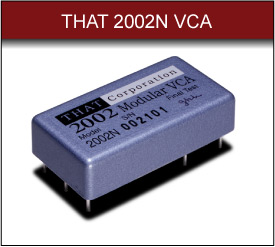The development of the voltage-controlled amplifier for professional audio use has a long history, and can provide some insight into the care and feeding of these essential devices. The following history was compiled from the collective memory of the THAT Corporation staff, and is believed to be a reasonably accurate, abbreviated summary of the evolution of VCAs since the early days of dbx.

The voltage-controlled amplifiers found in most recording consoles and analog effects products are based on the “Blackmer gain cell” developed by David Blackmer of dbx, Inc. The original dbx 202 “Black Can” VCAs, which can still be found in operating consoles today, have been around for over 20 years. These first VCAs suitable for pro audio equipment were built with discrete transistors that were individually matched in an oven. They were pretty noisy, and generated significant distortion at higher levels, but far exceeded the performance of other VCAs at that time, and became quite popular for early console automation.
There were a number of succeeding 202 VCAs, with each series evolving sonically as the state of the VCA art was advanced.
The earliest designs required trims for both transistor symmetry and log-slope. The next generation of dbx gain cell, developed by Gary Bergstrom, was made with pre-matched, discrete devices, and used a patented error correction scheme which improved its dynamic range. Like earlier designs, it suffered from thermal tracking problems and a limited dynamic range.
Around this time, users felt that the distortion levels of the VCAs were too high, and for a while VCA development centered on Class A designs. Competitors of dbx, Inc., including Paul Buff of Allison Research (and later Valley People), and David Baskind and Harvey Rubens of VCA Associates, fielded their own approaches, all aimed at overcoming the limitations of Blackmer’s early design. The Allison Research VCA was much like a Blackmer VCA running Class A, and had an exponential control port. Allison Research, in fact, paid a royalty to dbx, Inc. for certain aspects of this design. The VCA Associates VCA did not have an exponential control law, but had better thermal characteristics, since it was fabricated as an IC. It is not clear if any of the VCAs are still in production at this time.
About the same time, dbx, Inc. introduced its own Class A design, the 2001, designed by Bob Adams, now of Analog Devices. This was a discrete implementation like the Allison VCA, and also had an eight transistor gain cell like the Allison VCA, though the 2001 used these additional transistors in an active mode whereas the Allison VCA had them diode connected.
These Class A gain cells eliminated the need for a log-slope trim by virtue of their eight transistor architecture, but they presented significant thermal tracking problems in discrete form, and the eight transistor gain cell did not reach its full potential until it was fabricated in an IC process, where matching and tracking can be held to tight tolerances. Concurrent with the development of the 2001, Dave Welland of dbx, Inc. was working on an IC solution that implemented a Class AB design of the eight transistor gain cell and used the additional transistors to implement an improved correction scheme. These IC VCAs, the dbx 2150 et al, were current-in/current-out devices, and it soon became obvious that they could be paralleled. The open frame modular 202 series from dbx (and subsequently THAT Corporation), were built in this manner, and exhibited superior noise performance compared to the older varieties.
With the lower noise floor, however, other limitations became apparent, particularly in product designs that did not use an adequate degree of care in dealing with the peculiarities of those early VCAs. As a result, users began to notice certain subtle, audible anomalies that became identified with VCAs. Some of this “characteristic” sound no doubt resulted from the limited gain-bandwidth product of the op-amps inside the VCA (which in turn resulted from the relatively high parasitic capacitances typical of the junction isolated, complementary bipolar process used to fabricate the core ICs). At the same time, designers occasionally failed to adequately condition the signal feeding the control port of the VCA, resulting in excessive noise modulation and distortion.
In the meantime, the ownership of dbx, Inc. changed hands several times, and the various divisions of dbx, Inc. were individually sold during the dissolution of Carillon Technology Incorporated. The professional products division was sold to AKG which was later acquired by Harman. OEM products were bought by THAT Corporation, founded by dbx’s V.P. of Engineering, and members of his staff, and THAT became the source of the 202 VCAs.
To keep VCAs up to date with current technology, THAT Corporation began development on successors to dbx’s old line of VCAs. To overcome the problems related to limited GBW product, THAT Corporation’s newest IC VCAs, the 218X series of VCAs, was developed by Gary Hebert in a dielectrically isolated process, and has topological enhancements that minimize the effect of non-linearities in the VCA drive circuitry on high frequency distortion. These VCAs are equal or superior to their predecessors in every regard, and in particular, do not exhibit the rising distortion at higher frequencies characteristic of VCAs built on a junction isolated process.